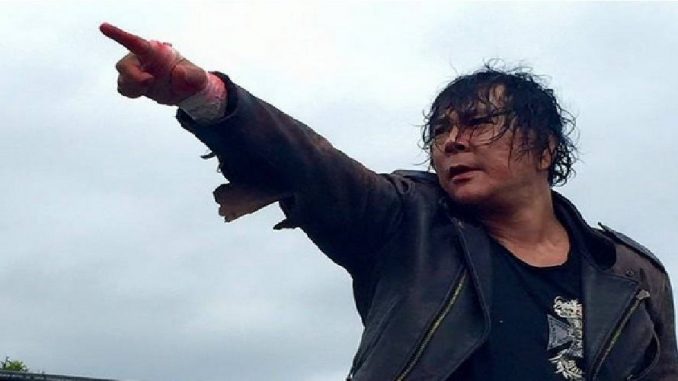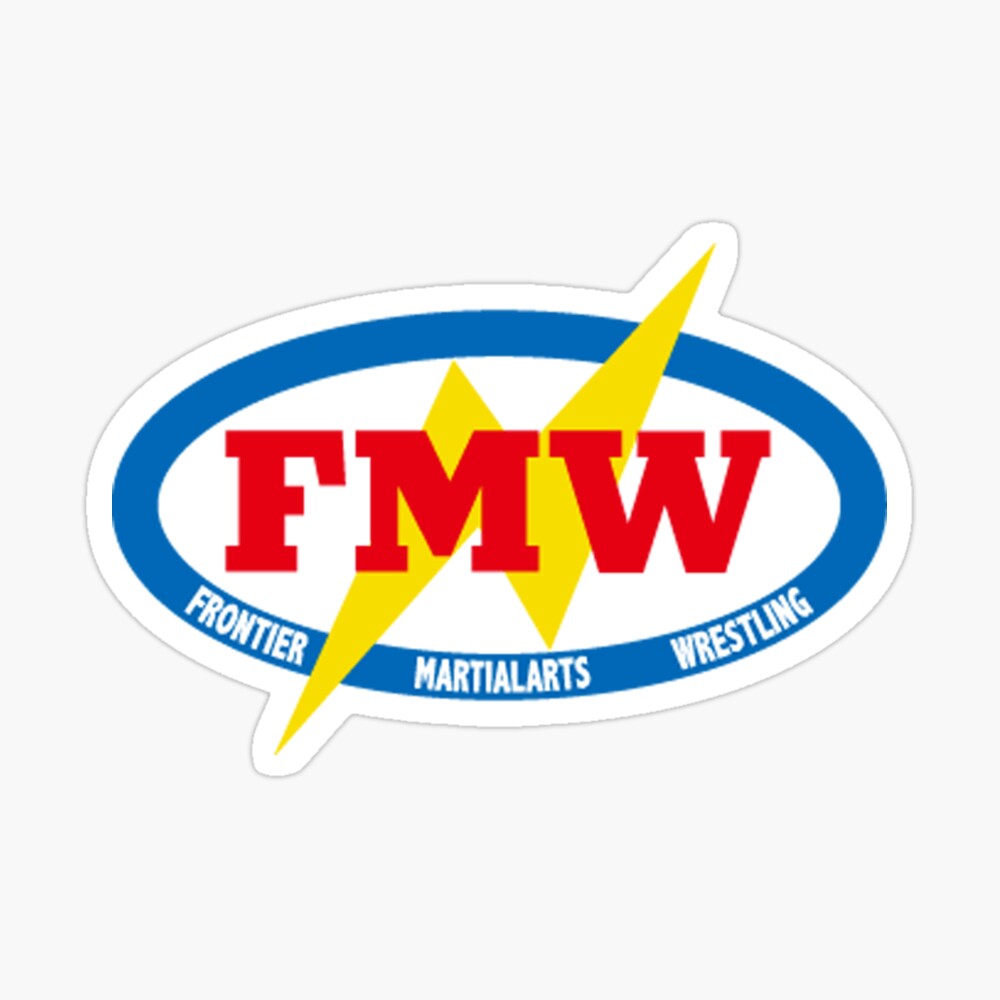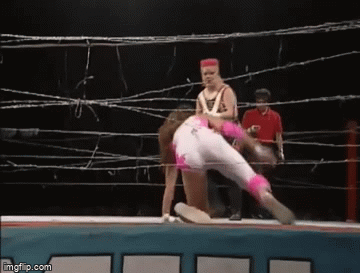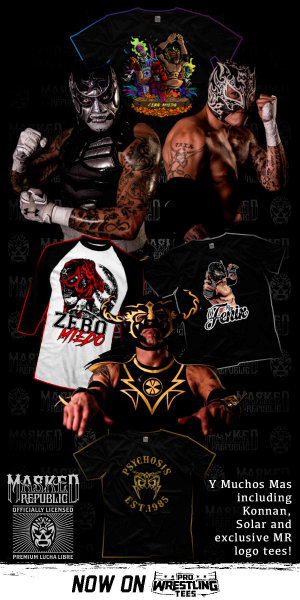Death Matches; they’re not for everyone! A very Captain Obvious statement I know. Ever since the death match style crawled out of the primordial ooze that were the bloody brawls of Puerto Rico and 1980’s Memphis scene the matches have been polarizing. For some the bloody ultra violence of barbed wire, light tubes and other weapons are the best thing since Sunkist Orange Soda; for others it’s worse than the Killers’ discography post Hot Fuzz. Where do I stand? The same place I stand with every other type of match; when done well, Death Match wrestling is like the “Jessie’s Girl” scene from Boogie Nights. Things go from 0 to 100 quickly, you’re guaranteed to be staring off into space wondering how the hell you got here, there’s a 50% chance firecrackers will be involved, blood is everywhere, by the end you’re completely mesmerized and Thomas Jane still wants what’s in that safe! It doesn’t get any wilder than a Death Match, which is probably why no major wrestling promotion has gone near one in recent memory. Well until this year at least.
In March, Jon Moxley and Kenny Omega battled at the AEW Revolution PPV in, you guessed it, a Death Match. But it wasn’t just any death match; it was Exploding Barbed Wire Death Match! I know right? There’s were two reactions after AEW announced the match; the first was “HOLY SHIT, AN EXPLODING BARBED WIRE DEATH MATCH!” The second was “what the hell is an Exploding Barbed Wire Death Match?” In the words of Peter Griffin, it’s exactly what it sounds like. An Exploding Barbed Wire Death Match features no ring ropes, which have been replaced with barbed wire that just so happens to have C4 attached to it. When a worker gets sent into the barbed wire, the barbed wire then explodes; this continues until there’s a pin fall or submission (at least in most cases). If you’re sitting there thinking there’s never been a match quite like this on the PPV of a mainstream US wrestling promotion, you would be correct! Save for one attempt over a decade ago (which we’ll get to), no televised wrestling promotion in North America had pulled off a match like this. So what gave AEW, Moxley and Omega the idea to do this? None other than a long lost Japanese promotion from the 1990’s, and their top star, the wildest man wrestling has ever seen, who together helped pioneer the match we’ll see this Sunday.

There’s never been anyone who fits their theme song, X’s cover of “Wild Thing”, quite like Atsushi Onita. He has done it all; first student of the legendary Giant Baba (who was like a father to him), All Japan-Pro Wrestling Junior Heavyweight ace, failed actor, politician and man who used government funds to arrange a threesome with a porn star. He sported the charisma of Hulk Hogan and El Santo, the brashness of a Kathleen Hanna scream and a knack for retiring and unretiring so much that Terry Funk couldn’t keep up. In between all of that he changed wrestling forever, starting with his first comeback in 1989 following retirement a few years earlier due to injuries. No longer able to perform at the high level required for a Junior Heavyweight star, rejected by shoot promotion Universal Wrestling Federation (UWF) and fuming over being DQ’d for using wrestling moves in a martial arts fight against Masashi Aoyagi, Onita decided to promote his own shows using the name Frontier Martial Arts Wrestling (FMW).
The idea initially was to use the FMW name to promote only two matches, both against Aoyagi. Instead the success of those bouts (where Aoyagi won first, followed by Onita winning the rematch) convinced Onita to start FMW as an independent promotion. Initially he built the promotion around two styles; martial arts style wrestling and the bloody brawls he witnessed while he toured Memphis in the late 70’s/early 80’s on excursion. You’ll never guess which style won out! Realizing he could hide his limitations behind the brutality and his selling, Onita turned FMW more and more into a hardcore promotion, incorporating weapons into the brawls. This carried on for about a year before the fortunes of FMW and Onita changed, thanks to a feud between Onita and former ally Tarzan Goto (ironically they feuded over what style was superior; martials arts or death match). The feud required something special to blow it off; enter the first ever Exploding Barbed Wire Death Match, held at FMW’s first Summer Spectacular event on August 4, 1990.

FMW, the birthplace of the Exploding Barbed Wire Death Match
Watching Onita-Goto back now is like watching a rookie wrestler in their first match; you can see the potential, but overall the experience is rougher than the second half of Gone With the Wind. But Onitia and Goto’s lack of technical skill was less important than the buzz it created. The Summer Spectacular drew over 4,500 fans to the Shiodome area in Tokyo, one of FMW’s largest crowds to date; only a month later the first FMW Anniversary show would draw and even better 7,352 at the Komazawa Gymnasium. The show, headlined by Onita taking on Goto’s ally Mr. Pogo in a Texas Death Match, became the most successful show done by an independent promotion in Japan at the time. And it was just the start; by the time 2nd Anniversary Show came around a year later, FMW found itself in the Kawasaki Stadium drawing 33,000. Once again the headliner was Onita vs. Goto and once again there was barbed wire and explosions involved. This time however Onita and Goto decided to add a bared wire steel cage, resulting in the first ever Exploding Barbed Wire Steel Cage Death Match. In less than a year FMW had gone from a small independent to a force, with Onita (who you’ll be shocked to learn won all three of those matches) as its Hulk Hogan and the Exploding Barbed Wire Death Match as its Hell in a Cell, only with more gore and more influence over Michael Bay.
From that developed the template of which FMW would build their promotion around for the next several years. Onita would feud with the likes of Pogo, Tiger Jeet Singh, Mitsuhirio Masunaga, old rival Aoyagi, Hideki Hosaka, Mike Awesome (under the name The Gladiator), Hayabusa and even the legendary Genichiro Tenryu, with each feud culminating in some variation the Exploding Barbed Wire Death Match. And these weren’t just minor tweaks; for example, one variation would feature exploding boards (in a match dubbed the Exploding Barbed Wire Double Hell Death Match). Several (like Onita-Goto) were held in a cage. Some were one on one matches, others were multi-man matches. Perhaps no variation was crazier than the Exploding Barbed Wire Dynamite Pool Elimination Death Match, which once again, is EXACTLY what it sounds like. You name it, FMW and Onita did it, and then blew it up like we did in the Planet of the Apes timeline.
None of these matches however could hold a candle to the headliner of the 4th FMW Anniversary show. That event saw Onita wrestle Funk, fellow master of retiring and unretiring, in an Exploding Barbed Wire Time Bomb Death Match. This was your standard garden variety Exploding Barbed Wire Death Match, with one major catch. After ten minutes passed a five minute timer would count down until the ring exploded, all while sirens wailed as if Kawasaki Stadium was under imminent threat of a missile attack. While Onita’s previous rivals had all been game, Funk committed to the match in a way no one had previously, other than Onita himself. The result was a captivating, wild brawl that saw Onita win with only a few minutes before detonation, followed by Onita, ever the good guy, shielding Funk from the blast. The ending, shot like a western and featuring a rad guitar solo, remains one of the most epic moments in wrestling history. That, along with the match quality and the then record 41,000 fans who attended the show Kawasaki Stadium (not to mention how great the match itself was) makes it hard to argue Funk-Onita wasn’t the peak of the Exploding Barbed Wire Death Match genre.

Alas it was not the most successful. Built around the stipulation of Onita retiring if he lost, his Exploding Barbed Wire Steel Cage Death Match with Tenryu at the 5th Anniversary Show drew a robust 52,000. Onita would in fact lose (aside from Singh, Tenyru was the only man to beat Onita at his peak in a match of an exploding nature) but ultimately decided to hold off on retiring in favor of a year long retirement tour. The tour concluded with him facing Hayabusa at the 6th FMW Anniversary Show. Second only to Funk-Onita in terms of quality (alright; maybe the Exploding Pool was better), Onita’s farewell drew 58,250, the largest crowd in FMW history and at $2.5 million in ticket sales the largest gate in FMW history. In five short years FMW went from a small independent to a promotion drawing nearly 60K fans for their biggest event, on the back of a major star (Onita) and a marquee match. The Vegas Golden Knights haven’t even had that good of a start to their existence, and they were one Alex Ovechkin away from a Stanley Cup.
Here’s the thing about good times though; they end. After Onita-Hayabusa it was all downhill for everyone involved. Less than a year later Onita would unretire and return to FMW. Instead of a heroes welcome, his return alienated some fans for him not holding to the retirement stipulation and his drawing power was never the same. To make matters worse, Onita passed on his ownership role of FMW to ring announcer Shoichi Arai upon his short lived retirement. Arai would soon be forced by DirectTV (who had agreed to air FMW shows on PPV for high dollars) to move FMW away from their hardcore style to a more WWE entertainment style; the move would help net FMW a wider audience but further alienated the core fan base (thanks to Twitter user @BAHUFMW for this info). Onita and Arai would clash upon Onita’s return, and the latter would eventually depart FMW for good towards the end of 1998. Attendance would flatline over the next several years and with Arai in serious debt (rumor is he owed money to the Yakuza), FMW closed its doors for good in February 2002. Tragically Arai committing suicide only a few months later, in case the tale of FMW’s end wasn’t dark enough for you. In the end the FMW wound up with the same story we see from other companies; promotion gets hot, promotion peaks in popularity, promotion never recovers, promotion fades away.
Till the end FMW continued to use the Exploding Barbed Wire Death Match as its marquee attraction. Most paled on comparison to the matches of old, but on occasion FMW would rediscover the magic. The most notable occurrence was at the 7th Anniversary Show, where female stars Megumi Kudo and Combat Toyoda collided in the first ever all female Exploding Barbed Wire Death Match in honor of Toyoda’s retirement. Many consider the match to be even better than some of Onita’s classics, and coupled with an Exploding Barbed Wire Double Hell Tag Team Death Match in the main event (featuring Pogo, Funk, Hayabusa and Masato Tanaka) the show drew a respectable 33,000. To this day, Kudo vs. Toyoda remains the highest profile Exploding Barbed Wire Death Match to involve female wrestlers.

FMW’s success led to other promotions giving explosives a go. The most famous example was IWA-Japan, another independent promotion, which produced a memorable Cactus Jack-Terry Funk Exploding Barbed Wire Board & Exploding Time Bomb Death Match in August of 1995. Onita would also take the match elsewhere, taking on Great Sasuke in an Exploding Barbed Wire Death Match in Michinoku Pro Wrestling and more famously battling Masahiro Chono in the opening match of New Japan’s Strong Style Symphony in April of 1999. Just as famous for its entrances as the explosions (Onita’s entrance to X’s “Wild Thing” is iconic, with Chono entering in a Hummer closely following), over 63,000 saw the match in the Tokyo Dome, making it the most attended Exploding Barbed Wire Death Match ever. Onita would do two more variations of the match for New Japan over the next year (the most famous against the Great Muta in a totally normal Exploding Barbed Wire Barricade Explosive Landmine Double Hell Death Match) before departing. Along with FMW closing its doors two years later, it effectively put an end to the Exploding Barbed Wire Death Match as a major Japanese attraction. Today you’re more likely to find the original cut of Mascara Sagrada vs. Black Cat than a match like that.
As rare as the match now is in Japan it’s been even rarer in North America. Independent promotions such as Combat Zone Wrestling (CZW), Xtreme Pro Wrestling (XPW) and IWA Mid-South have all attempted the match at least once, with limited success. Extreme Championship Wrestling (ECW) famously brought Onita in in 1997 to set up an Exploding Barbed Wire Death Match with The Sandman, only the match never took place. Years later ECW would do Balls Mahoney vs. Vic Grimes in an Exploding Barbed Wire Death Match…at a house show. This would be the funniest Exploding Death Match story if not for XPW featuring an Exploding Ring Scaffold match that featured Shane Douglas shooting someone with a tranquilizer dart (a true story!). As far a televised wrestling promotions go, only one has to attempt any kind of Exploding Death Match on TV. The promotion; Wrestling Society X. That’s right, the brain child of Lucha Central’s own Kevin Kleinrock actually attempted to put an Exploding Death match on TV when The Filth and the Fury (Matt Cross and Teddy Hart) took on Team Dragon Gate (Geinki Horiguchi and Masato Yoshino) in an Exploding Time Bomb Cage Match. Sadly it didn’t happen; despite being filmed and scheduled for WSX’s season one finale, the match never ended up airing on TV due to MTV canceling WSX weeks earlier. As such that match, available on YouTube, became the closest thing to an Exploding Death Match of any kind airing on North American TV or PPV for a decade and a half. And then Moxley vs. Omega came along.

So how did play out? When I originally wrote this column back in March, I theorized that Moxley and Omega, despite being two of the best workers in Exploding Death Match history, wouldn’t be able to live up to the masterpiece that was Funk vs. Omega. As it turns out I was right! While the work by both men was exceptional and the explosions were solid, the defining legacy of AEW’s Exploding Barbed Wire Death Match was that the final explosion was lamer than an argument with Bully Ray on Twitter. We got sparklers, we got a couple minor booms and an overall dud, a far cry from the climax Funk and Onita delivered. Perhaps in the long run that was the reason so many US promotions shied away from the Exploding Barbed Wire Death Match. It all looks good on paper, but if the execution isn’t there then you’re basically like Donald Sutherland in JFK, standing there with your you-know-what in the wind. It’s why AEW’s Exploding Barbed Wire Death Match is now looked upon as one of the biggest, pardon the pun, bombs in the promotion’s short history, and makes it a 50-50 chance that AEW never attempts a match like that again.
Then again perhaps the key here isn’t whether AEW pulled it off or not and more that they actually tried it at all. Say what you will about WWE, good or bad, but never in a million years would they attempt this match for a variety of reasons. No one would. In a way it’s what sets AEW apart from the rest; no matter how outrageous, they will give anything the old college try. Maybe it’ll be great or maybe, as it was in this case, it’ll be a bust. But more than 30 years after Atsushi Onita invented it, it was great to see the Exploding Barbed Wire Death Match still has some chapters left to be written. And look what’s happened since then. Onita relaunched FMW as a promotion that specializes in Exploding Barbed Wire Death matches, holding its first show in March. Dark Side of the Ring’s third season has an episode that will chronicle Onita, FMW and the Exploding Barbed Wire Death Match. AEW’s version may have been a dude, but there’s no question it brought attention and excitement to the match in a way that hadn’t been around in over two decades. And I for one am happy to see a comeback, in more ways than one, for the Exploding Barbed Wire Death Match. It’s a match that has seen the streets of Tokyo, Kanazawa Stadium, the Tokyo Dome, Asbury Park and now Daily’s Place Amphitheater. And like everything else in wrestling, it’s not always perfect but when it is? Well it’ll blow you away.
I know; lame final line. Couldn’t resist.

Please change disks to continue…
Folks! We invite you to also follow us through our official social media accounts:
© 2021 Lucha Central



